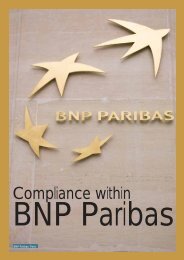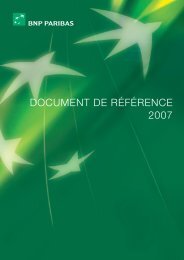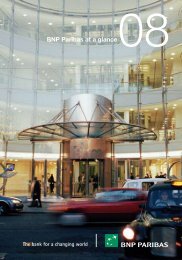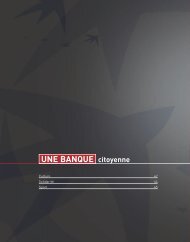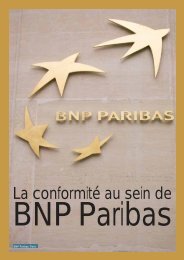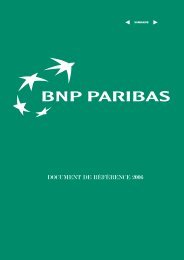2007 REGISTRATION DOCUMENT
2007 REGISTRATION DOCUMENT
2007 REGISTRATION DOCUMENT
- No tags were found...
You also want an ePaper? Increase the reach of your titles
YUMPU automatically turns print PDFs into web optimized ePapers that Google loves.
5 NotesCONSOLIDATED FINANCIAL STATEMENTSto the financial s tatements p repared in accordance with I nternational Financial Reporting S tandards as adopted by the European Union< Contents >To reduce the risk resulting from a deterioration in the inherent creditquality of a portfolio of financial instruments, BNP Paribas has developeda dynamic hedging strategy based on the purchase of market instrumentssuch as credit derivatives.4.b MARKET RISKS RELATED TO FINANCIALINSTRUMENTSMarket risk is the risk of gains or losses due to changes in marketparameters such as interest rates, exchange rates, and equity orcommodity prices. The main market risks faced by the Group are definedbelow:■ Interest rate risk covers potential fluctuations in the value of fixed-ratefinancial instruments or financial instruments indexed to a marketbenchmark due to changes in market interest rates, and in future cashflows on floating-rate financial instruments.■ Currency risk is the risk that the value of an instrument or of futurecash flows from that instrument will fluctuate due to changes inforeign exchange rates.■ Price risk arises from changes in market prices, whether caused byfactors specific to an individual instrument or issuer or by factorsaffecting all instruments traded on the market. This may relate, forexample, to changes in the price or volatility of shares, stock marketindices or commodities. Variable-income securities, equity derivativesand commodity derivatives are exposed to this risk.■ Credit spread risk on the trading book: BNP Paribas trades activelyin credit derivatives to meet the needs of its customers. Transactionsinclude trades in ordinary instruments such as credit default swaps,and structured transactions with complex risk profiles tailored totargeted strategies. As part of this trading activity, BNP Paribas buysand sells protection; the net position is subject to strict limits. Marketrisks generated by these products are tracked by the Capital MarketRisk unit, in the same way as for other derivatives risks. The underlyingcounterparty risk is also covered by normal risk managementprocesses.■ Options give rise to an intrinsic volatility and correlation risk, whoseparameters can be determined from observable prices of optionstraded in an active market.Market risks arise mainly from the trading activities carried out by theFixed Income and Equities teams within Corporate and InvestmentBanking.4.b.1Risk a cceptance p rocessThe trading book market risk acceptance structure is based on:■ general exposure limits. These take the form of GEaR (Gross Earnings atRisk) limits or “nominal” limits (limits on trading volumes and activitiesin financial instruments exposed to country risk, issuer risk limits, andsensitivity limits to contain certain specific risks not fully capturedby GEaR or stress tests);■ rolled-down exposure limits. These are derived from the powers ofthe Chief Executive Officer and the Capital Market Risk Committee.For secondary market trading, they are expressed in terms of GEaRor OYE (One year Equivalent); for underwriting activities, they referto a signature quality scale;■ decision-making rules. Risk acceptance involves a two-prongeddecision-making process, combining a validation process for newactivities or new risks with an approval process for transactionsarising from routine business. Large or complex transactions mustbe approved by the Executive Position Committee (EPC), an offshoot ofthe Capital Market Risk Committee. Responsibility for analysing creditrisk on trading activities lies with the Group Credit Committee.Risk monitoring is based on:■ daily calculation of the value of the Group’s trading positions andrelated exposures;■ daily monitoring of compliance with the limits set for each activity,with accidental or authorised temporary trading limit overruns loggedin a central database;■ periodic reviews of market risk measurement and managementmodels, with the measurement process subject to regular audits byindividuals from outside the business line who review and assess theeconomic validity of the models, check the prices and parametersused, and check observability criteria;■ a weekly report aggregating all significant positions by activity;■ the Capital Market Risk Committee, which meets monthly to approvethe main market risks incurred by the Group.4.b.2Measurement of m arket r isk on t radinga ctivitiesMarket risk on trading activities is measured and assessed by performingdetailed sensitivity analyses of each type of position, and global analyses,such as GEaR and stress tests that measure aggregate exposures.Analysis of sensitivity to market parametersIn the first instance, market risk is analysed by systematically measuringportfolio sensitivity to the various market parameters. The informationobtained is used to set tolerance ranges for maturities and for optionstrike prices. These sensitivity indicators, compiled at various aggregateposition levels, are compared with the market limits, and are reportedto Executive Management and to the heads of the trading units by theCapital Market Risk unit.Value at RiskBNP Paribas uses an internal Value at Risk (VaR) model, approved bythe banking supervisor, to estimate the potential loss arising from anunfavourable change in market conditions, the key element in marketrisk measurement.Potential losses are measured using “Value at Risk” (VaR). VaR takes intoaccount a large number of variables that could affect portfolio values,including interest rates, credit spreads, exchange rates, securities prices,commodity prices, and the volatility of and correlation between thesevariables.The system uses the latest simulation techniques and includes processingof non-linear (convex) positions, as well as the volatility risk generatedby options. Daily movements in the different variables are simulated toestimate potential losses on market transactions under normal marketconditions and normal market liquidity. VaR calculation methods arecontinually fine-tuned to better reflect the specific features of eachbusiness, especially as regards exotic products. The accuracy of the modelis constantly tested by comparing any daily losses with 1-day VaR.1234567891011144<strong>2007</strong> Registration document - BNP PARIBAS



